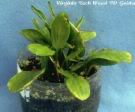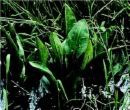

Scientific Name
Alisma subcordatum
Uses of American Water Plantain: Landscaping, Medicinal, Culinary, etc...
Waterfowl and upland birds readily consume the seed of this broadleaf species, but the roots have not been observed to be eaten. Its small white and yellow flower are attractive, having potential use in water gardens.
General Characteristics
This light to yellow green, erect herbaceous perennial can reach heights of about 3 feet. The ovate to lanceolate shaped leaves emerge from a 1 1/4 to 6 inch long stem. Each leaf has a primary mid-vein which is flanked by three subparallel veins. Leaf stems emerge from bulb-like corms which have shallow fibrous roots. Vegetative spread is slow and radial. This species relies on population spread by seed. Independent, single or multiple, whorl branched inflorescence rise from the plant base to a height of 3 1\2 feet. White to pinkish 3 petaled flowers bloom from June to September on compound panicles. Numerous flat, keeled, achenes form terminally in tight rings, mature from July to October. Seedlings will emerge on exposed soils, in stands of existing vegetation or newly disturbed locations.
Required Growing Conditions
The native range of water plantain is from Massachusetts to Minnesota, south to Florida and Texas. This broadleaf emergent can be found growing in shallow, quiet to slow moving water, and in mud of marshes, ponds, lakes, streams, ditches, and seeps. It requires organic or silty soils, with seasonally or permanently inundated freshwater
Cultivation and Care
This species can be established effectively by vegetative divisions or seed. Bare-root or containerized vegetative propagules are used to effectively establish plantain within its hydric regime. It is easy to handle this form of material due to its small size, ease of separation, and plantability. On site and nursery seedings are not as predictable; water plantain requires specific after ripening, stratification, and germination conditions before emergence will occur. Once established onto a site with ideal hydrology, this species will continue to re-seed itself for as long as the ideal environmental conditions exist. Ideal sites for germination require direct sunlight, finely textured soils, and adequate sustained soil moisture.
General Upkeep and Control
On manageable sites, water depths must be kept moist to flooded
Pests and Potential Problems There are no known detrimental pests of this species.





0 comments: